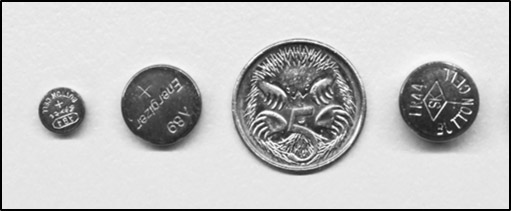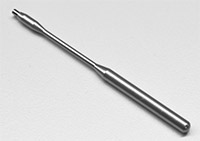View resources
Key points
- Consequences of nasal foreign bodies range from local irritation at insertion site, to serious complications including death.
- Urgent referral to ENT (onsite or via Retrieval Services Queensland (RSQ)) is required for button batteries and paired magnets due to the risk of necrosis of surrounding tissue.
- The first attempt at removal of a foreign body from the nose has the best chance of success.
- Refer to ENT for removal if first attempt (via any method) is unsuccessful.
Purpose
This document provides clinical guidance for all staff involved in the care and management of a child presenting to an Emergency Department (ED) in Queensland with a suspected or confirmed foreign body in the nose.
This guideline has been developed by senior ED clinicians and Paediatricians across Queensland, with input from ENT specialists, Queensland Children’s Hospital, Brisbane. It has been endorsed for use across Queensland by the Queensland Emergency Care of Children Working Group in partnership with the Queensland Emergency Department Strategic Advisory Panel and the Healthcare Improvement Unit, Clinical Excellence Queensland.
Introduction
Nasal foreign bodies are more common in the following children:
- aged two to five years
- intellectual impairment (may have multiple foreign bodies and repeated episodes)
Common foreign bodies include food, paper and small toy parts. Most nasal foreign bodies are found in the anterior nasal cavity between the floor of the nose and inferior turbinate.1 High rates (92-98%) of successful removal in ED have been reported.
Button batteries
Button batteries require immediate removal due to the risk of necrosis of the surrounding tissue.

There are two main mechanisms by which button batteries can cause necrosis:
- where there is sufficient retained battery charge, hydrolysis and creation of hydroxide ions in adjacent tissues leads to mucosal burn at battery’s negative pole
- direct pressure
Despite prompt removal, the risk of injury can continue up to weeks post-insertion due to residual alkali and weakened tissues.
Assessment
Button batteries require immediate removal to prevent necrosis of surrounding tissue and septal perforation.
When to suspect a foreign body in the nose
Most children with a nasal foreign body are asymptomatic. A history of insertion may be reported by the child or the caregiver. Delayed presentations are usually triggered by parents noticing blood stained purulent discharge or a bad smell.
Regardless of a history of insertion, consider a nasal foreign body in children presenting with any of the following symptoms:
- nasal occlusion
- epistaxis
- malodourous, purulent or blood-stained nasal discharge (usually unilateral but may be bilateral if multiple foreign bodies or in case of septal perforation)
- facial swelling and/or facial pain
| Upper respiratory tract infection |
| Rhinitis |
| Sinusitis |
| Unilateral choanal atresia |
| Tumour |
Investigations
X-rays are not routinely recommended as the objects inserted are rarely radiopaque but must be considered if there is a possibility of a button battery or paired magnets which cannot be directly visualised.
Contact Retrieval Services Queensland (RSQ) to arrange urgent transfer of a child with a suspected button battery and no X-ray facilities are onsite.
Management
Refer to flowchart [PDF 211.2 KB] for a summary of the emergency management for a child with a nasal foreign body.
Urgent ENT referral (onsite or via RSQ) is required for the following children:
- button battery in nose
- history of insertion and bleeding or airway issues
Refer to ENT as per local practices in the following circumstances:
- multiple unsuccessful attempts at removal prior to ED presentation
- foreign body is posterior and not easily visualised
- paired magnets or magnet and metallic object across nasal septum
- chronic or impacted foreign bodies with marked inflammation
- penetrating or hooked foreign bodies
Principals of foreign body removal
- first attempt offers the best chance of success
- choose the best method based on exact location, shape and composition of foreign body (see methods below)
- be aware of the risk of trauma and/or posterior displacement and aspiration in a poorly compliant child
Preparation for foreign body removal
- engage two staff members to assist (in addition to carer)
- provide developmentally appropriate information and encouragement and use demonstration or role play to prepare the child for the procedure
- position the child appropriately (upright or lying down)
- upright positioning encourages a sense of control thereby minimising distress
- ideal upright positioning is on the carer’s lap with his/her head supported by staff member
- may be easier to secure younger children lying down
- refer to CHQ Nursing Standard 62111: Clinical Holding – Holding and Supporting Children [PDF] (QH only)
- use auditory and visual distraction techniques and promote child’s coping skills
- prior to mechanical extraction, consider applying topical local analgesia such as Co-Phenylcaine Forte (5% Lignocaine, 0.5% Phenylephrine) at appropriate doses using flexible nozzle extension (maximum single dose of 3mg/kg Lignocaine) 10 minutes prior to removal (not routinely recommended prior to removal by positive pressure techniques)
- use a head lamp (+/- magnification) to optimise visualisation and allow the use of two hands
- consider using a nasal speculum to maximise visualisation (place in a cephalo-caudal orientation to avoid the nasal septum)
Blind attempts at removal are not recommended due to risk of posterior dislodgement and aspiration.
Topical nasal drops including local anaesthetic and vasodilators are contra-indicated in button battery cases. They may increase the risk of posterior displacement and aspiration or local necrosis.
Methods of removal
Recommended methods of removal include positive pressure or mechanical extraction. Positive pressure methods aim to push the foreign object anteriorly either completely out of nasal passage or into a visible range where it can be grasped by other instruments. These methods carry a theoretical risk of barotrauma including periorbital subcutaneous emphysema. Irrigation and use of glue are not routinely recommended.
Sedation is not recommended as may increase the risk of aspiration.
The risk of aspiration in foreign bodies that are unable to be removed is estimated to be 1 in 1,500 patients.2 Referral for elective removal is therefore acceptable with appropriate safety-net advice for the family.
Positive pressure removal methods for nasal foreign body
| Method | Indication | Description |
|---|---|---|
| Self-blow/ exhale technique |
|
|
| Parent’s kiss |
|
|
Mechanical extraction removal methods for nasal foreign body
| Method | Indication | Description |
|---|---|---|
| Forceps (including Magill, alligator, packing, toothed and non-toothed forceps) |
|
|
| Probe (e.g. Jobson-Horne probe) |
|
|
| Suction |
|
|
| Balloon catheter (e.g. small foley or commercial catheter) |
|
|
Magnetic device
|
|
|
Refer to ENT as per local practice if first attempt at removal of foreign body (via any method) is unsuccessful.
Post-removal care
- inspect nasal orifice to exclude co-existing foreign body and trauma
- examine other nasal and aural orifices for additional foreign bodies
Potential complications following removal of nasal foreign body
- rhinorrhoea
- epistaxis
- ulceration of the nasal mucosa
- perforation of nasal septum
- nasal or choanal stenosis
- infection
- ingestion
- sinusitis
- periorbital cellulitis
- meningitis
In the event of epistaxis, apply direct pressure to control the bleeding. Refer to Epistaxis guideline [PDF] (QH only).
Refer to ENT as per local practice in child with significant complications.
Escalation and advice outside of ED
Clinicians can contact the services below to escalate the care of a paediatric patient as per local practices. Button battery cases require urgent transfer if removal onsite is not possible. Other nasal foreign bodies requiring specialist referral are usually managed as an outpatient.
Button battery insertions
Button batteries require immediate removal to prevent necrosis of surrounding tissue.
| Service | Reason for contact | Contact |
|---|---|---|
| ENT | For urgent removal of button battery. | Onsite or via Retrieval Services Queensland (RSQ). For facilities with no onsite service contact RSQ (Ph: 1300 799 127) to request urgent transfer of a child:
RSQ (access via QH intranet). Notify early of children potentially requiring transfer. |
Other insertions
| Reason for contact by clinician | Contact |
|---|---|
For the management of children with the following nasal foreign bodies:
For specialist advice regarding significant complications following successful removal of foreign body in ED. | Onsite/local ENT service as per local practices. |
Disposition
A child may be discharged following successful removal of the foreign body.
On discharge, provide accident prevention advice to caregiver/s including:
- safe storage of small objects including marbles, coins, button batteries and balloons to ensure out of reach of infants and young children
- ensuring toys for play are appropriate for developmental age
Follow-up
- advise caregiver/s to seek medical attention if child experiences any signs or symptoms of complications such as fever, purulent nasal discharge, epistaxis, facial pain and/or swelling
- referral to ENT as per local practice any child with significant complications following foreign body removal
-
- Kiger, J.R., Brenkert, T.E., Losek J.D., (2008), ‘Nasal Foreign Body Removal in Children’, Pediatric Emergency Care, Vol. Nov 24 (11) pp 785-792
- Qureshi, A.A., Lowe, D.A., McKiernan, D.C, (2009) ‘The origin of bronchial foreign bodies: a retrospective study and literature review’, European Archives of Otorhinolaryngology, Vol. 266 pp. 1645-1648
-
Document ID: CHQ-GDL-60022
Version number: 2.0
Supersedes: 1.0
Approval date: 02/03/2023
Effective date: 02/03/2023
Review date: 02/03/2025
Executive sponsor: Executive Director Medical Services
Author/custodian: Queensland Emergency Care Children Working Group
Applicable to: Queensland Health medical and nursing staff
Document source: Internal (QHEPS) + External
Authorisation: Executive Director Clinical Services
Keywords: Foreign body, nose, nasal, button battery, ENT, paediatric, emergency, guideline, children, 60022
Accreditation references: NSQHS Standards (1-8): 1, 3, 8
-
This guideline is intended as a guide and provided for information purposes only. View full disclaimer.
Last updated: October 2023
